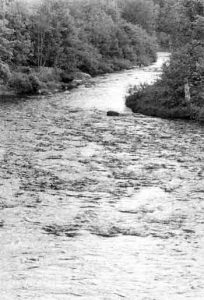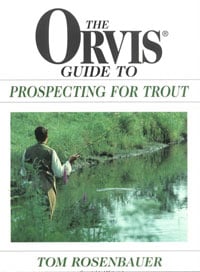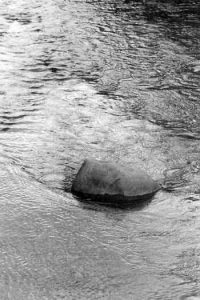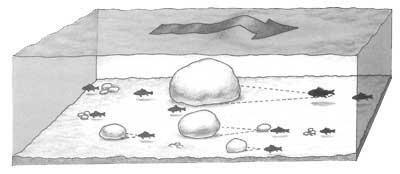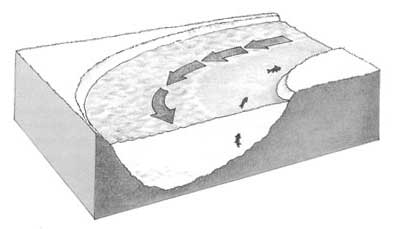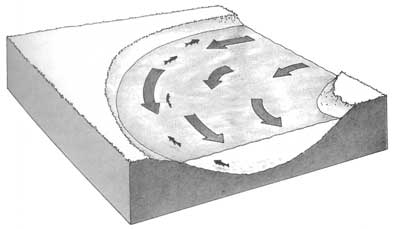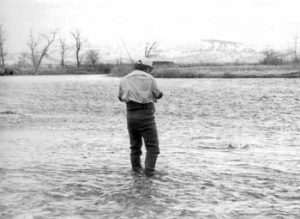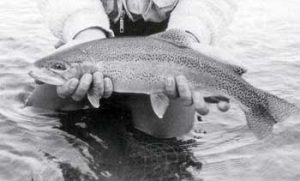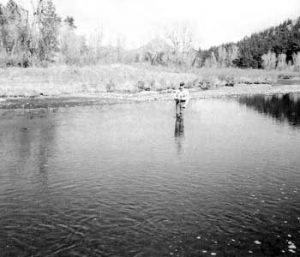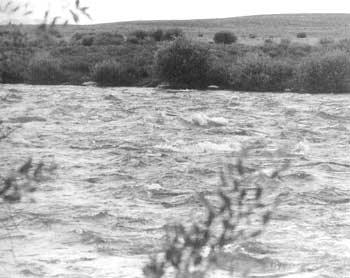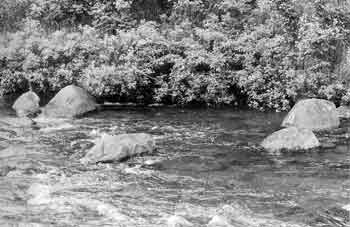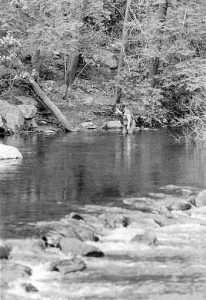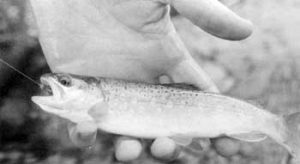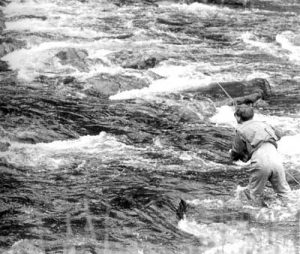Reading the Water
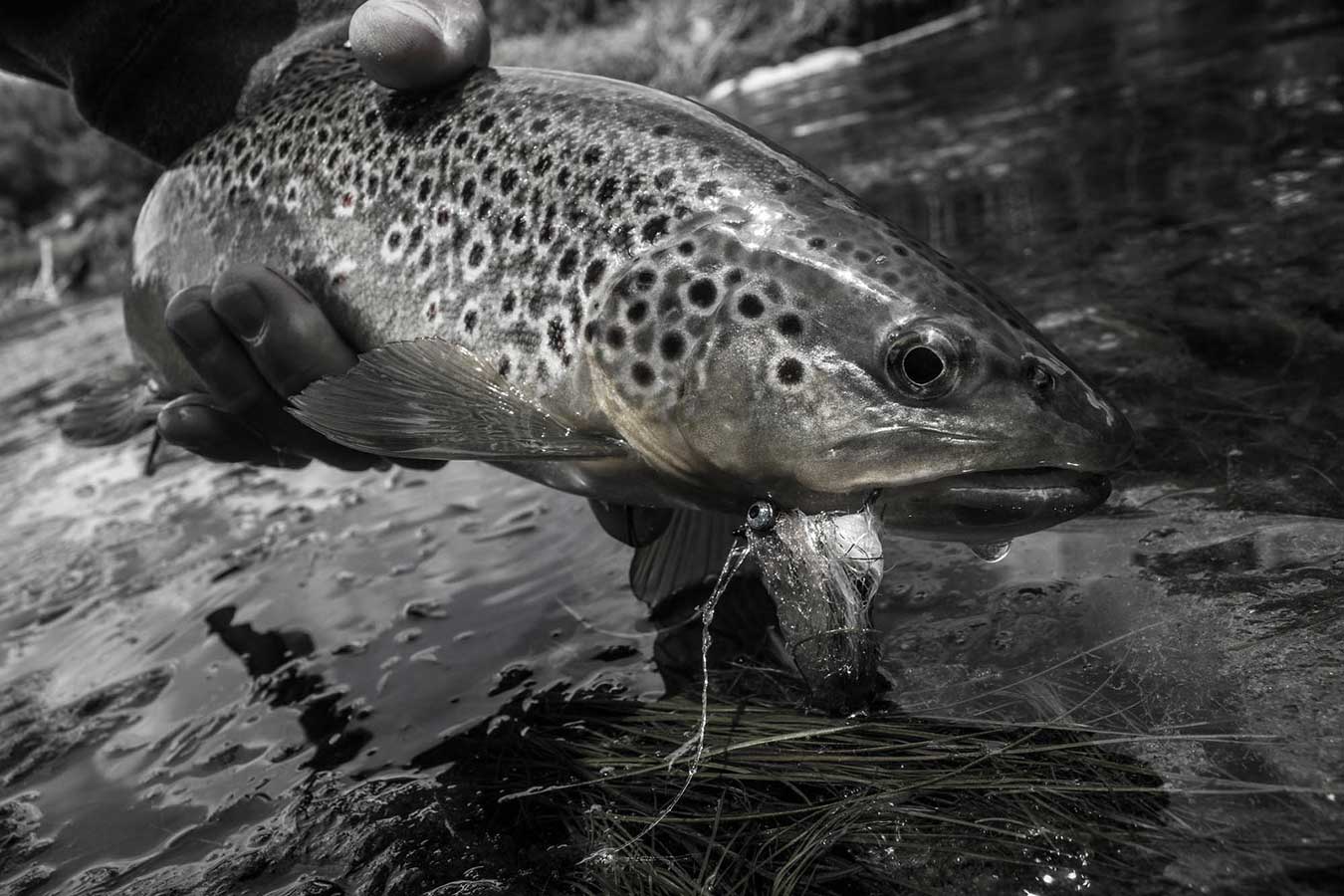
Mike Doughty photo
SOME WATER that is easily fished during a hatch is tough to blind-fish with consistent success. Stream reading is a vital skill for prospecting, but you should approach a day of fishing with the philosophy that not all places in a stream hold trout, and others that may hold trout cannot be blind-fished easily.
When you cast to rising fish, you know exactly where each fish is, you have a good idea what they’re eating, and you stalk one fish at a time. You know the fish are willing to feed, and if your casting is accurate you know they can see your fly. On the other hand, when blind-fishing, you must constantly keep two questions in mind: Can he see my fly, and can he see me? If he sees you before he sees your fly, the fish will be spooked, and even if he doesn’t bolt for cover he won’t be interested in eating. You must have confidence in your ability to locate unseen fish, and you must be able to make a decent presentation to the narrow range where a suspected fish can see your fly.
In general slow water is the hardest water to fish blind, for a number of reasons. Slow water is more difficult to read, because in big pools you don’t have the benefit of differing currents to narrow the possibilities of where you may find a trout. In a riffle or run much of the water is too fast for a trout holding in place, and some of the water is also too shallow. Trout will be found in narrow, easily recognizable bands where fast water meets slow, deep water meets shallow, or rocks or shelves offer relief from the current. It is difficult to cover slow water without spooking the fish, because fish in slower currents get a much better look at the outside world and the food they’re eating. In a riffle you can drop your line right on top of a trout without spooking him, so a thirty-foot drift will effectively cover thirty feet of water. In slow water, though, a thirty-foot drift will cover a maximum of fifteen feet, the length of the longest leader most of us can handle, and the trout lying under the fifteen feet of fly line will probably be spooked. Frankly most of us lack the patience to blind-fish slow water. The fly drifts so slowly that we lose interest and confidence in what we are doing.
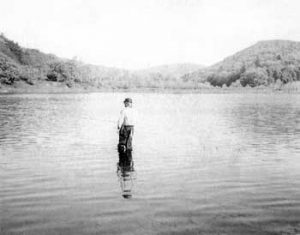
A giant slow pool, like this one on the Delaware, is difficult to read and to prospect for trout in.
You’ve seen fish rising in your favorite pool on another day when there was a good Sulphur hatch, so you know exactly where they are lying, right? Sorry. Those fish may be lying below the same spot you saw them rising, but in slow water, especially during a heavy hatch or spinner fall, trout often move from their normal lies into places where they can capture floating food with greater ease.
There are ways of finding trout in slow water, which we’ll explore a little later in this chapter, and there are methods of fishing that work in slow water, which I’ll talk about in later chapters. Vermont’s Battenkill has miles of slow, deep water that I have tried to blind-fish with a nymph or dry during every month of the season, but I find myself spooking an entire pool before I can get a fish to look at my fly. Where a riffle punctuates the slow water, I’ll do fine, but between the infrequent fast water I find myself relying on streamers, which can be fished independent of the current and for which trout will move from ten or even twenty feet away. On the other hand, when conditions are right in faster water, I can take trout on dries, wets, nymphs, or streamers.
So prospecting for trout relies heavily on riffles, runs, and pocket water, which is fine because in a heavily fished stream this is the water most fishermen ignore. When there are no hatches, I always start fishing at the head of a pool or run, in pocket water, or in a riffle, and then I graduate to the slower water if I can figure out what is going on. Fish in rough water are less easily disturbed, and they’re also less wise to the dangers of artificial bugs. Trout fishing is supposed to be challenging, but I am quite content with the dumbest, least neurotic trout available if there is no hatch to even the odds.
Why Trout Need Special Places
When Thomas Jenkins built his artificial channel in Convict Creek, he found that different trout introduced into the channel separately used virtually the same feeding positions, even if a whole new group of trout replaced a previous group. The positions used didn’t offer more food than the unused sites, but Jenkins thought the sites used offered better energetics — in other words, the fish could obtain their food without wasting more energy than they were gaining. Energetics is the basis of learning to read a stream. Trout need enough food passing by their position to have an almost constant supply, yet they need to lie in areas where the current velocity is nearly zero.
Bob Bachman has determined that brown trout prefer to lie in water with a speed from one-quarter to one-half foot per second and feed in water running about two feet per second. Rainbows generally feed in faster water, up to about six feet per second, while brook trout and cutthroats like about the same current speeds as browns. In a stream that offers all four species you’ll often find the rainbows at the head of a pool and the other species in the middle and the tail of the pool, or in places where a large object slows the current. The current at the surface of a tumbling mountain stream might be ten feet per second, the fastest water in an average riffleand-pool lowland stream six feet per second, and the middle of a slow pool at low water approaching that magic half a foot per second. This is why you’ll see trout hanging just below the surface in the middle or tail of a pool during a good hatch or spinner fall at low water — the current is slow enough that the fish can comfortably lie and feed in the same place.
The usual scenario, though, is for trout to lie in slower current and dart into faster current to grab a piece of food. A fish might lie behind a rock and move to the side, where food is washed around the rock. Another fish might lie on a rubble-strewn streambed and slide up into the faster water just above the bottom. The places to look for trout are areas where fast water meets slow, adjacent to the main current. How do trout find these places? One theory is that they “hear” a particular chord of sounds with their lateral line. Apparently every place in a stream has a unique sound fingerprint.
You can find the main current by watching the line of bubbles and debris that snakes its way through a pool or run. Look up to the head of a pool and find the fast water spilling into it, then trace its path through the pool to find the places where trout anchor themselves. Understanding stream richness will help you determine how close to the main current trout will be found — in an infertile stream they will be locked onto its edges like cars waiting on a highway entrance ramp. As richness increases they will be found farther and farther away, in the side streets and alleys.
Fishermen call these current-speed transition zones seams, and if you know nothing else about reading the water, you can find trout by looking for them. If you board a drift boat with a guide, the first thing he’ll tell you is to hit the seams. Loosely defined, almost any place a trout feeds is a seam, because trout almost always lie in slow water and feed in faster adjacent currents. But seams formed by two currents of different direction and velocity are especially useful because they can help you find trout where there are no bottom obstructions to break the current, or where you can’t see the obstruction on the bottom. When two currents meet, there is always a pocket of relative calm within the turbulence, and often it is enough to form a place where trout can lie and feed in comfort, even when there are no rocks, logs, or shelves. Seams like this form between the slow water next to a bank and the main current, below an island where currents re-form, or along the edges of a fast chute.
Less obvious than horizontal differences in current are the vertical ones. Anytime water encounters an object, friction slows the current and causes turbulence. Water that flows through a smooth pipe is nearly laminar, meaning most of the water molecules are running in the same direction. A trout stream never approaches anything near laminar flow, as the roughness of the streambed, the banks, and objects such as gravel bars and logs slow down the water, deflect the flow from a straight downstream course, and cause turbulence. That is why water in a straight piece of stream is fastest in the center of the river, near the surface. The closer to the banks and the bottom, the greater the friction, the greater the turbulence, and the slower the downstream progress of the water. Not surprisingly, then, in a stream of reasonable velocity without midstream obstructions you find most trout near the banks or on the bottom.
Reading Surface Currents
Reading the water is often spoken about as if it’s some kind of voodoo that only grizzled old men who smoke pipes and have many patches on their waders understand. They are supposed to be able to make magic predictions by translating the fingerprints of surface currents into signs that point directly to trout. Stream reading skills do improve with experience, but no good stream reader depends entirely on surface currents; in fact you should only use surface currents if you have no other clues. As a bonefish guide on Christmas Island told me, “Don’t look at the water, look into it, look through it.” With a decent pair of polarized sunglasses and a little training — teaching your eyes what to look for — you’ll be able to see deeper into the water. You’ll also be able to spot trout on those rare occasions when they are visible. Don’t think it takes vision like The Man of Steel’s, either. It just takes experience learning what to look for. My eyesight has always been poor, and I wear strong contact lenses so that I can use polarized sunglasses and still take them off when it rains. A friend of mine, a commercial shell fisherman, can spot a flock of gulls wheeling over the water at least a half mile before I can, yet when we fish together I can spot trout and submerged rocks that he never sees. It’s simply a matter of picking up patterns.
There are times, however, when you’ll have to depend on reading surface currents: when the water is too dirty to see more than a foot into it; when glare that polarized sunglasses can’t block obscures the water, especially in the morning and evening; or in a riffle where bubbles and surface turbulence hide what’s underneath.
Midstream Rocks
Perhaps the most over-studied situation involves a submerged rock surrounded by either sand or gravel, so the rock stands out as an obvious trout haven in an otherwise unattractive spot. When water meets an immovable object, some of the water is stopped dead, and the kinetic energy it had is transformed into potential energy. Water gets potential energy by piling itself higher and gaining altitude, and you can see this at the head of a submerged rock. A bump in the water surface shows you where the rock begins; this bump is always slightly downstream of the rock because the current pushes it. It’s a comfortable place for a trout to live because the current is slowed considerably, yet food is constantly pushed to him. Sometimes the force of the current digs a hole, giving the trout a place to bolt to when an osprey’s shadow darkens the water.
When water rushes over a submerged object, an area of slower water forms just behind the object, and the difference in velocity causes turbulence. If the water is sufficiently shallow and fast, the turbulence carries to the surface and tells us where behind the rock the area of slower current is located. Trout like these places behind rocks, but not always and not everywhere. When you see standing waves or loads of foam behind a submerged rock, you may not find any trout directly behind it. The current’s force is too great, the swirly turbulence may make it difficult for a trout to hold his position, and the unpredictability makes it hard for him to see and to intercept his prey. The current behind a large rock or boulder may be so slow that it offers little food. Only when the rock is no larger than a television set and the current moderate enough to form gentle swirls behind it are you likely to find a trout with his nose up against the rock.
Many more trout, and bigger ones, feed at the edges of the current that swirls around a rock and near the tail of the plume that extends downstream. I call the downstream end of the V-shaped plume, where it narrows to a point, the ‘focal point,’ and the focal point is usually the best spot of all for trout. Lying here, trout can feed from currents coming around both sides of the rock without fighting the violent turbulence that often forms just behind the rock.
Seldom do you find a single rock lying in a riffle or run like a spot on a clean mirror. Usually the mirror is covered with spots of all shapes and sizes, and if most of the bottom is covered with boulders and cobbles, fishermen call it ‘pocket water.’ This stuff is a blind-fisherman’s delight: the trout here usually feed all day long. They are easy to approach, and they are not too picky about their fly selection. Stand off to the side and look for places where the focal point of one nice rock intersects the bump in front of another rock, or where a family of rocks form a minipool with its own bump, edges, and focal point. Because trout feed on drift that comes in front of the rock or slides off to the sides, I avoid dropping my fly in the swirly water right behind the rock, even though it’s tempting to slam your first cast right there. Try it a couple of times and you’ll see why it should be avoided — placing your fly there without dumping piles of slack into the leader will give you almost immediate drag, and a trout may be put off your fly on successive casts, even if they are drag-free. A trout that is lying around looking for food but not preoccupied with a hatch can be spooked much easier by a fly that drags than a trout that is filling his face with bugs. If you begin by placing your fly in front of the rock a few times and then try a drift along each side, it will be easier to get repeated drag-free floats. The water in these places runs uniformly downstream, so it’s less likely that a squirrelly current will make your fly go south when the leader is heading north.
If you just can’t resist plopping your fly in that gurgling mess right behind the rock, don’t use a dead-drifted nymph or dry. Try a streamer, or a skating caddis or spider — something that laughs in the face of convoluted currents.
The Head of the Pool — An Easy Spot for Prospecting
Often the water is too deep for you to pick out individual rocks, or the rocks are too small to be differentiated from the characteristic marks on the surface. Even though trout will key in on certain rocks no bigger than themselves, and fish will lie on top of or just behind certain rocks year after year, no one has come up with a formula for predicting what rocks offer exactly the right hydraulics. I hope they never do. When you can’t locate the rocks, you have to use other clues. The head of a pool or run is the first place I go, because the water there is faster than in the rest of the pool, so the fish will be easier to approach and fool. (I never told you we would always force ourselves to do this the hard way, did I?) Water coming into a pool, right in the tongue as it spills over whatever obstruction forms the head of the pool, may often be too fast to hold trout. Without a log or rock to block the current’s force, this part of a pool may be sterile. Usually, though, as the current entering a pool starts to flatten and slow (typically just below the standing waves, if there are any), there will be a shelf, with an area of calm water below its lip. Here trout can hold in comfort and have the pick of the current. If you can tell me how to get to them in early spring, when there are four feet of raging current above them, then you should be writing this book instead of me. Once in a while, if you twist enough lead in front of a streamer, toss it above the pool, and strip just as it drops over the lip, you might draw one out of the maelstrom. But in the early season the water generally is too cold for a trout to chase anything moving faster than a crawl, so you’re out of luck anyway. You can try those guys under the waterfall in midsummer, when the current barely whispers over their heads. There are easier places at the head of the pool.
Look at the edges of the fast current on either side of the tongue, the place New Zealanders call the “eye” of the pool. If there is a bend in the river at the head of the pool, as there often is (do you know how hard it is to find a “classic” pool with mirror-image seams on either side?), there will be an inside and outside bend. Where most of the trout will be found depends on current speed. In fast current, where the water on the outside bend smashes against the bank, you’ll find more trout on the inside. The outside may even be completely sterile. I once coveted a spot on a favorite trout stream where the current plowed up against the far bank, carving a dark undercut. I never saw a trout rise there and never hooked one blindfishing, so I assumed there was a monster brown in residence. One steamy August day when even bobbing away in an inner tube looked inviting, I put on a diving mask and poked around. I was disappointed. Not only were there no trout in a place I had paid much attention to over the years, the bottom was as smooth as a beach pebble and offered not one place for a trout to get out of the current.
On the other hand, if the current is so slow that leaves and other debris collect on the inside of the bend, you’ll find more trout on the faster outside, where the meager current will bring them the most food. In streams with poor to average fertility you would expect to find trout where there is at least some current to bring them food, but in a rich river trout can be anywhere, including those neglected backwaters. Also, if the head of a pool is formed by a gentle riffle rather than a slick tongue of fast water, you’ll find trout distributed all across the riffle, not just at the seams on both sides of the tongue.
Turbulence is what makes the head of a pool easier to fish. At the tail of a pool, and usually in the middle, the water velocity is stratified: faster water is at the top, where your fly enters, and much slower water is near the bottom, where the trout lie. When you cast a dry fly upstream in the tail of a pool, the water closest to you is accelerating before it dumps over into the next pool or riffle, so drag sets in almost as soon as your fly lands, making it move unnaturally.
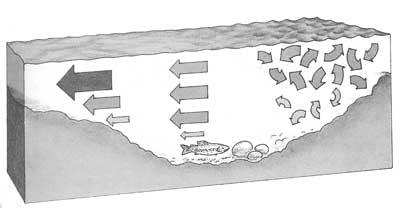
At the head of a pool water velocity is more uniform in a vertical cross section; it stratifies in the middle and tail.
When you cast a nymph upstream, it starts to sink, but the leader and line on top of the water are moving faster, so they begin to pull the fly upward, keeping it out of the productive water below and, again, dragging unnaturally. Your choices include dumping a lot of slack into the cast when fishing a dry or nymph upstream, using a technique that is independent of the current, such as a streamer, or using a technique that uses current to your advantage, like a swung wet fly or a skating caddis. If you’re unfamiliar with these techniques, don’t worry; I’ll describe them in later chapters.
At the head of a pool or riffle, though, turbulence mixes the currents so they’re much less stratified. The downstream progress of the water is impeded, making it easier to slip a nymph through the currents or to get a drag-free float with a dry fly. And you can still swing a streamer or wet fly through these currents, so your options are doubled.
Riffles and Soft Spots
Plain, boring old riffles are some of the easiest and most productive places to blind-fish, because the way the water moves conspires against the trout. Current speeds seem uniform both vertically and horizontally: the many cells of turbulence are so small that they produce, for practical purposes, a uniform body of water, lessening drag on a dry fly or a nymph. Contrast a riffle, with its many tiny goose bumps of turbulence showing on the surface, to a boiling slick, where the turbulence cells are larger, big enough to grab your leader and wrench your fly. In a boiling slick the turbulence may even be strong enough to push a trout out of position constantly. Since trout like predictability, if they have to fight for position or they can’t accurately take a piece of food, they’ll move in a hurry. Unless I’m streamer fishing or I have seen a decent trout rising in them (which is seldom), I avoid boiling slicks like a bank full of worm fishermen.
Datus Proper, in his thought-provoking and iconoclastic book What the Trout Said, describes places he calls “soft spots.” These are places where almost anything you do will produce a strike — places that Proper takes rank beginners to bolster their confidence. Every stream I fish has some soft spots, which I have found through experience, and I use them for special guests, children, and impatient or discouraged fishing buddies. All of the soft spots I know are in gentle riffles, lacking either strong whorls of current or the rooster tails of standing waves.
A wide expanse of riffle, whether at the head of a pool or in a transition between pools, seems at first to have no features. Look harder. First you’ll notice seams at the edge of the riffle, and these are worth much of your time and effort. Out in the middle of the riffle, look for slicks — areas that look as though someone polished and flattened the bumps on the surface. Slicks are formed either when the water is too deep for the turbulence formed by contact with the bottom to reach the surface, or when the water is slowed by a plateau in the streambed or an object on the bottom. If there is enough water, all of these places will hold trout. Depth is a limiting factor for trout abundance only when the water is so shallow that trout feel insecure about holding in it. In a riffle the water may be too shallow to hold adult trout, because as a rule they need to have a foot of water over their backs and a nearby refuge. So look for the places where the water is too deep for you to see the stones on the bottom clearly; when looking at slicks, make sure they are big enough or deep enough that a trout can find a place to hide when you stumble up through the currents. A slick the size of a kitchen sink in the center of a shallow riffle might offer all the food and protection from fast currents a trout needs, but a trout won’t stay alive there for long unless the merganser population has flown south for the winter.
If you can find a slick the size of a bathtub with secure cover nearby, you may find a trout that everyone else has missed. I remember one place in a shallow riffle I must have walked through fifty times without a cast. There was an old dead tree trailing in the riffle, and at the downstream end was a tiny pocket, barely deep enough to cover my ankles. I stared and thought I could see bare stream bottom, but I cast a Gray Fox Variant anyway. A brown shape formed seemingly out of the gravel, rose to meet the fly, moved without apparent haste to the tangle of branches, and broke my leader. I have been back to the same place another fifty times and have not seen that trout again.
The Middle of the Pool
The middle of a pool also often looks featureless, without the obvious seams between fast and slow water that guide you to trout at the head. If there is nothing else to guide me, I can find the best fish in the middle of a pool by tracing the main threads of current down through it. Look up to the head and follow the line of bubbles and debris carried by the current, and you’ll see the best feeding positions. Even if the places where the main current flows are shallower or offer less cover than water off to the side, you’ll find more trout, and especially more feeding trout, where the current brings a constant stream of food.
Look on the bottom for lines of color that show a dramatic change in depth. Trout may hide in the dark depths when you stumble through a pool, but deep water doesn’t offer much food. If the depth suddenly changes from eight feet to two feet, all the food being carried by the current is forced into a narrow vertical choke point, and a trout here can see all the food that the current carries. In the bottom of a hole he can see only a fraction of it. Look too for rubble on the bottom, as opposed to sand or gravel. The rougher the bottom, the greater the number of nooks and crannies that offer places to hide and pockets of slower water, energy-efficient places for a trout to live and feed. If the water isn’t too slow or too shallow, you’ll be able to spot these places if you can’t “see” into the water by reading the roughness of the surface.
Don’t Ignore Springs . . .
In the early and late season a spring or small tributary entering a pool will concentrate the fish. Springs reflect the average mean temperature of a given latitude, and because of the insulating effect of the ground they hold a constant temperature year-round, just as your basement does. So in early spring, when the river water is 45 degrees, the temperature of an entering spring could be closer to 50, a more comfortable temperature that will encourage more feeding. In August, when the temperature of the river is 72 degrees with a corresponding decrease of oxygen, the spring will be around 55 degrees, and it may often be a question of survival rather than mere comfort that keeps trout with their noses stuck into the cold water. The Firehole in Yellowstone Park is a river that suffers from high summer water temperatures because of the hundreds of geysers, mud pots, and boiling water pools that flow into it. One August day I found a cold spring flowing into the Firehole opposite the famous Ojo Caliente hot spring. There were more than twenty trout packed into a shallow, barren flat below the spring, and they were unusually spooky, but I found that a tiny Pheasant Tail nymph dropped into the crowd would get a nod if I rested the pool after the previous fish I’d taken. It was the first time I had fished the Firehole, and had I not wanted desperately to catch a trout there, I would have left them alone, as they were vulnerable and stressed by living in this crowded, exposed environment. Since that day I have avoided cool springs in extremely hot weather, preferring to fish near them only when a couple of trout have moved in for comfort, not when an entire pool has migrated there out of desperation. You’re the predator, though, and you can make that decision on your own.
. . . or the Banks
Reading the water by looking at the banks is often ignored, but the banks in many streams (not just meadow streams with undercuts) are the most important fish-holding features. Unless a bank has a shallow slope without cover and is made from fine gravel or the water along it is so shallow that a trout’s back would poke out, you’ll find trout somewhere along this edge. Generally one bank is better than the other. When you’re fishing blind, fish are spookier than if they’re preoccupied with a hatch, and because you’ll have to favor one of the banks when wading up or down (unless the river is so big you have to fish the same bank you’re wading), it’s important to look over both banks before you enter the water.
If the river is so fast in the middle that it is difficult for you to wade, there is nothing to break the current, and there are no twists to make current seams, you can be certain that any decent trout around will be near one or both banks. Which one should you choose? Just as you evaluated the middle of the pool, look at the head of the pool or riffle to see where the current is directing most of the food. Usually the current will bounce the main volume of water toward one bank or the other. But wait, you say;trout don’t need to worry about aquatic insects when they live near the banksbecause they have plenty of terrestrial insects falling right on top of their heads. It’s true that in some rivers terrestrial insects make up the bulk of a trout’s diet, but contrary to what most fishermen say and believe terrestrial insects are no more important to trout near the banks than to trout in the middle of the river. I remember casting to a large brown trout rising to leafhoppers and beetles in an upstate New York river one windy day, and I counted thirteen fly changes until I got him to take. He was in the middle of the river, fifty feet from either bank. One early morning on the Madison I walked the bank upstream from the Raynolds Pass Bridge. I rose dozens of bigspotted browns on a hopper right next to the bank, but when I turned my attention to the middle, the rainbows on the seams of the fast water ate the hopper just as eagerly.
There is a simple reason for my not thinking terrestrials are more important to fish living near the banks: An object falling into a river is quickly drawn into the center. If a grasshopper or cricket or beetle or ant falls into the water and isn’t eaten right away by a trout living next to the bank, it will soon be available to those guys out in the center. In tiny brooks or shallow streams the deeper bank is usually better. You should make sure, however, that some current is getting to the deeper bank, because sometimes the deep bank is an almost stagnant backwater. Huge trout can use these deep places for refuge, but they don’t eat there, so trying to get one to take is like pitching to a batter while he’s sleeping. If one bank slopes gently up from the river and the other is made from ledge rock or is otherwise steeper, the steep bank is likely to be better. In huge, fast rivers where the current along the deeper bank might be moving at ten feet per second and the water might be twenty feet deep, I’d take a look at the shallower bank first. There might be a trout underneath that twenty feet of fast water, but you’re not going to have much luck getting a fly to where he’ll see it and feel inclined to move for it.
Once you’ve identified the better bank, make sure as you fish that you keep your eye on where the good water peters out, as often the good water switches from one bank to another. Because you’re not looking for rising fish but casting to likely stream features, you can sometimes tighten the blinders too much and wade right through some water you should be fishing rather than blundering through.
Any object that breaks up the outline of the bank will increase its attractiveness to trout. Where a deep riffle runs along a bank, look for a point of land that sticks out. Just like a rock in the middle of a river, the point will form two choice places for trout to lie — one just upstream of the point where the water is backed up to form a dead spot, and another area just downstream. If the point sticks out more than a foot from the bank, you might think that the most or best fish will be found close to the bank in the backwater right behind the point. My experience has shown that most trout, and certainly the bigger ones, prefer to lie just inside the seam behind the point. This place makes sense for trout because it offers protection from the full brunt of the current and easy access to food being carried by the current. If you toss a twig into the backwater behind an object, it will whirl around for many revolutions before it rejoins the current, and some fishermen argue that trout like to be in backwaters because they get multiple looks at pieces of food. I think they are more concerned with getting enough to eat than with admiring their next meal.
I also like to think this is true because getting a fly behind a point of land just inside a fast current and maintaining a natural drift is difficult without throwing piles of slack or adding a six-foot tippet. I’d rather throw my fly into the easier current just outside the point for a longer natural drift and hope the trout just inside can easily slide over and inhale my fly. If he is tucked way back, he may still see my fly and rush over for it. Only after I’ve attempted every permutation of drifts on the outside will I try the nasty water in the backwater.
Rocky banks are good. A jumble of rocks offers many havens from the current, with plenty of areas of different current speeds and seams. Narrow lanes between rocks concentrate the current — and move the food — into alleys, simplifying feeding. Any kind of vegetation will also make the bank more attractive to trout, even if the vegetation overhangs the water and doesn’t break the current. Shrubs hanging over the water offer trout security from predators. Luckily for fishermen, if there is a tunnel of alders along the bank, trout will not feed way back inside the tunnel but will lie just to the outside of the brush, using the dark interior only if they are frightened. Logs along a bank, whether parallel or perpendicular to the current, offer protection and breaks from the current.
A tree that has fallen into the water at a right angle to the current, usually with the trunk still attached to the bank, is called a ‘sweeper.’ The best places near a sweeper are at the outside tip of the branches extending downstream along the seam, and in front of the crotch where the sweeper meets the bank. Both places offer breaks from the current and a steady food supply. Often a line of trout extends below the tips of the branches, with the biggest fish upstream and the size decreasing as you go downstream, because a trout will not tolerate a smaller or less aggressive fish in front of it. Downstream of the sweeper is often barren water. If it contains trout, they’ll be much smaller than you’d think, because the sweeper strains food from the current and pushes it to the outside leaving slim pickings to the trout behind.
A log lying parallel to the current will probably hold more trout than a sweeper of the same size, because the entire length of the log offers attractive feeding grounds. When I was a teenager, I fished a productive stream that runs through the limestone bedrock of upstate New York. This river had all the attractive haunts a trout stream could possibly offer, but as far as my sampling could determine, one log in particular held the biggest fish. About fifteen feet long and five feet from the bank, the log always held several small trout; two six-inch nubs were left from branches that had been broken off over the years. And anchored at these nubs were the two best trout in the pool, one twenty inches long and the other nineteen. All these trout fed on the outside edge of the log, and even though there was a good five feet of dark, deep, protected water between the log and the bank, I never saw a trout rise and never caught one there.
The subject of banks brings up the question of cover — the degree trout use it, and the amount they need. Anyone who has studied a piece of trout water for any time has seen trout feeding out in the open, away from obvious cover. The energetics of getting enough food seem to be far more important than safety from predators. But even if you can’t see it, you can bet that trout feeding in the open have a place to run to nearby, and that they have memorized the route. Brown trout seem to place more importance than other species on cover, and if they can find a spot that offers food, protection from the current, and cover, they’ll stay close to cover. When you hook a brown trout, he will invariably head for the nearest log or rock. The other day I was fishing a stream that holds both browns and rainbows, and out in the middle of a pool I hooked a rainbow that tailwalked in place four or five times, ran upstream, and then grudgingly headed downstream to be released. I cast to another fish rising in almost the same spot, except this trout streaked downstream before I even knew he was hooked, and he used a submerged root six feet ahead of me to remove the fly from his jaw as cleanly as popping the top off a beer bottle. He swam past me with an arrogant flip of his tail, and left my fly stuck firmly in the root, all before I could begin to strip in my line. As the fish passed, I saw the dark spots of a brown trout along his back.
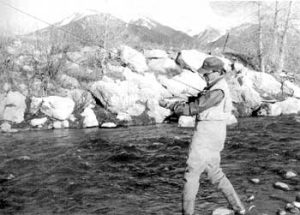
Rainbows will usually be found in more open water, whether it’s riffly like this or slow and smooth.
Brown trout have even been known to burrow in gravel when frightened, but the behavior of frightened rainbows betrays their lack of concern with overhead cover. Rainbows, when spooked, usually head en masse to the deepest part of a pool, and when you walk by you can observe what biologists call “fright huddles” — groups of rainbows all packed together, fins trembling. You never see browns mixed in with them because all the browns have headed to the bank with its more substantial cover. Brook trout seem to use cover less than browns but more than rainbows, so you will more often find them farther from cover and from the bank than browns. Where cutthroats and brook trout are found together, biologists have seen more use of cover by the brook trout. So if you know a river contains only brown trout, spend more time casting tight to the banks than out in the middle. If it holds only rainbows, bless their hearts, you can concentrate on the easier places in the middle of the river. But don’t ever completely ignore the banks. The middle of the Railroad Ranch section of Henry’s Fork in Idaho is essentially featureless, as most of the water is one long flat without big rocks. The better rainbows are near the banks, possibly because of cover, but more likely because the current along the banks is reduced enough to form areas of slower water with access to the food carried by the current.
The Most Difficult Part of a Pool
Everything I’ve said about rocks and banks and logs applies to the tail of a pool as well, and in most of the rivers I’ve fished, the tails hold the largest trout. All the food passing through a pool is channeled at the tail into a vertically and horizontally constricted funnel, and the smooth water here allows a nearly unobstructed view of the outside world, which warns of the approach of all kinds of predators. During a hatch the tail of a pool is the first place I’ll go to catch a trout that will pull line off my reel. It is also the last place I’ll go to prospect. When a trout in the tail of a pool is preoccupied with feeding and you know exactly where he is, approaching him is still difficult; when he is not actively feeding, it is masochistic. Because the tail of a pool is shallower than the middle, look for the deepest place in the tail to hold the most trout, barring any rocks or logs in the water. The place where the tail begins to shallow, where dark water gives way to lighter-colored water, will often be where trout are lined up to feed. If the water close to the banks is deeper than in the middle, and especially when vegetation meets the water, you’ll often find more and bigger trout next to the banks than out in the middle.
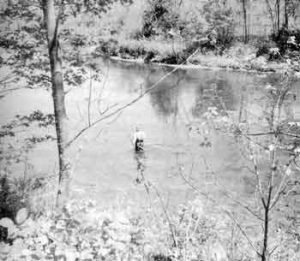
The nastiest part of a pool — the tail.
When you stand at the tail of a pool and fish upstream, following the usual line of attack, the water at your feet is faster than the water you cast into. The water in the tail is always accelerating, particularly in the early season when the current is faster. As soon as your fly lands, drag sets in, and even throwing big piles of slack will not always counteract this problem. You can get a better presentation by casting from upstream or from across-stream and throwing upstream curves, and this works best early in the season when you can get closer to the trout without spooking them. In midsummer I find that from above you spook the fish in the tails of most pools, especially in smaller streams or when the water is unusually low.
Because most aquatic insects live in riffles, and everything that hatches in a pool that doesn’t fly away will be funneled into the tail (as will any terrestrial insect that falls into the water), trout in the tail of a pool seem more aware of surface food than trout in any other place. If you stand and watch long enough, you will often see them sipping here throughout the day, especially in the low water of late season. This is not really a hatch situation; it is opportunistic surface feeding at every little morsel that drifts by. Sometimes you can watch for twenty minutes before you see a rise, so if you’re moving at a normal pace you won’t spot the fish, and you’ll fish the tail blind. During the summer, when the current has slowed enough, you can often make a short, accurate upstream presentation from a trout’s blind spot. But since your drift will still be short before it drags, decide first where you think the trout will be lying — don’t just blast away at random. It’s a good idea to study the surface currents for several minutes as well. If you can get close enough to where you think a trout might be, and you can figure an angle from which you can get a drag-free float, a terrestrial pattern or small spinner imitation in the middle of the day may rise a trout of a size you would normally see only during the evening hatch.
Even in the same stream at the same time of year, you cannot approach the tail of a pool with the casual tactics that might work in a riffle. If you want to catch trout in the tails of pools, study the last chapter on approach carefully. In the technique chapters that follow, note these techniques that have worked best for me in the tails of pools: actively stripped streamers, swung wets, and skated dry flies.
How the Setting Can Change
Four minutes from where I sit in an office eight hours a day is a tiny stream that is my laboratory, escape valve, and forty-five-minute retreat. I can fish three or four pools on my lunch hour. In one favorite half-mile stretch I know virtually every fish except the unseen brown trout that I suspect inhabit a couple of deep undercut banks at the base of streamside maples. I have never caught one of these elusive browns, but I imagine them sulking in a tangle of drowned roots, oblivious to my flies but capable of eating a six-inch brook trout followed by a three-day fast. At the beginning of each season I mark a couple of gullible brook trout by clipping their adipose fins so I can follow their progress through the season. If I can figure out where they are living, I can almost always catch them. In early spring they are in the deeper, slower pools, and to catch them you need a large nymph fished close to the bottom, with no drag at all. As water temperatures rise above 55 degrees and flies start to hatch, they will be pulled from the pools into shallow riffles. Now a dry fly will work, as will a wet fly or nymph that swings across the current. As water levels fall during the summer, they can be hard to find, and whenever I fail to catch one that has been in the same spot for a couple of months, I start to imagine my brookie in an aluminumfoil coffin in somebody’s freezer, or in the belly of a heron or otter. With the lower water levels it’s also likely that there are fewer places in this little stream that can hold trout, and my friends were pushed downstream by more aggressive trout. In summer most of the trout are concentrated in only the deepest holes and in the heads of pools — it may be a hundred feet between places that hold trout.
During the winter and early in the season trout are more concerned with avoiding anchor ice and floods than they are with eating. There are few insects in the drift for them to capture, and their metabolisms are slowed to the point where they take little advantage of the food that might be available. Shallow water can be scoured by floating ice and anchor ice, which grows from the bottom of the river, so look for trout in deep-water refuges, out of the main current. When there is no ice, though, I have caught them on sunny days in shallow riffles, and because I doubt trout spend the winter in water like this, I suspect they move into places that are warmed by the sun as spring starts to wake up the river. As the water temperature approaches 50 degrees, and insects begin to drift and hatch, the fish migrate to shallow riffles and the heads of pools to take advantage of insect life at its source. You can gauge the migration time by the first major hatch of the season. In the East, if you blind-fish before the Hendrickson hatch, you’ll find most trout in the side eddies and backwaters, but as soon as this first big hatch begins, the trout appear in riffles, in tails of pools, and out in the main current. They’re still there on days when the flies don’t hatch, and early in the morning on days when flies don’t hatch until midafternoon.
There they will stay until low water and high temperatures shrink the comfortable places in a stream and concentrate the trout. As habitats contract, trout don’t move far, sometimes just from one side of the pool to another, or from the middle to the head. In the tail of a big pool on the lower Battenkill, I found a pod of a half-dozen large brown trout one late spring evening, and I returned a couple of evenings a week to work them over. By the middle of the summer I had caught and released most of them, including a couple that I fin-clipped. A vacation kept me away from them for ten days, and when I returned the places where they had been feeding were almost dry. I couldn’t find a single one. One night I happened to look at the other side of the river, which was deeper but had never produced a fish, I guess because this deeper pocket was out of the main current and did not supply enough food. There were several good fish rising there, and sure enough, over the next several weeks I caught some that I had clipped. As I looked carefully at the water, I saw that their new home was deep enough to keep them secure. The current had shifted because of a newly exposed gravel bar, and by the looks of the bubble line coming down through the pool, most of the food was now funneled to the opposite side of the river.
In the tough late season there are three keys to finding trout: temperature, oxygen, and flow. If you remember them, you will catch trout all day long, even in the noonday heat of August when there is slim chance of any kind of hatch.
Temperature: Look for springs entering the river. Even springs whose surface flow runs dry during the summer usually offer some flow below the dry channel, so a scar of clean rocks along the bank that looks as though it might have been a tributary in early spring may tip you off to some cooler water. In general any entering tributary will be cooler than the main river, so look for trout below the confluence of a smaller and a larger stream. Wade wet to find springs entering the river beneath the streambed.
Oxygen: Water’s oxygen content is inversely related to its temperature, so if you can’t find the cooler water, which holds more oxygen, look for places where oxygen is forced into the water by physical means. Riffles, runs, pocket water, the bases of dams — trout will move to these places in midsummer, often leaving the rest of a pool barren.
Flow: This important factor of midsummer trout fishing is often overlooked. Trout won’t live where they can’t eat, and during low water their options are limited, making stream reading easier. Especially in slower pools, don’t look for trout anywhere but right under the bubble line, because flow is reduced to a point where only the
main current offers enough food. If you can’t locate the bubble line or it doesn’t seem to help, another way of finding trout is to look at the stones on the bottom. Once when I was fishing a stream known for its wild rainbows, I was in a wide riffle that holds scores of trout during the spring, and I knew some of them had to be around, even though the water looked too shallow. At first the entire riffle looked daunting and I couldn’t decide where to start. Then as I stared at the water, I noticed something. Most of the rocks on the bottom were covered with a thin film of dusty-looking silt, but in places that were slightly deeper and had a stronger current, the rocks had been wiped clean. That gave me some targets, and by pitching a Flashabou Caddis Larva into the narrow lanes of clean stones, I picked up a half-dozen ten-inch fish, more than I would have expected in such a flat, shallow riffle.
